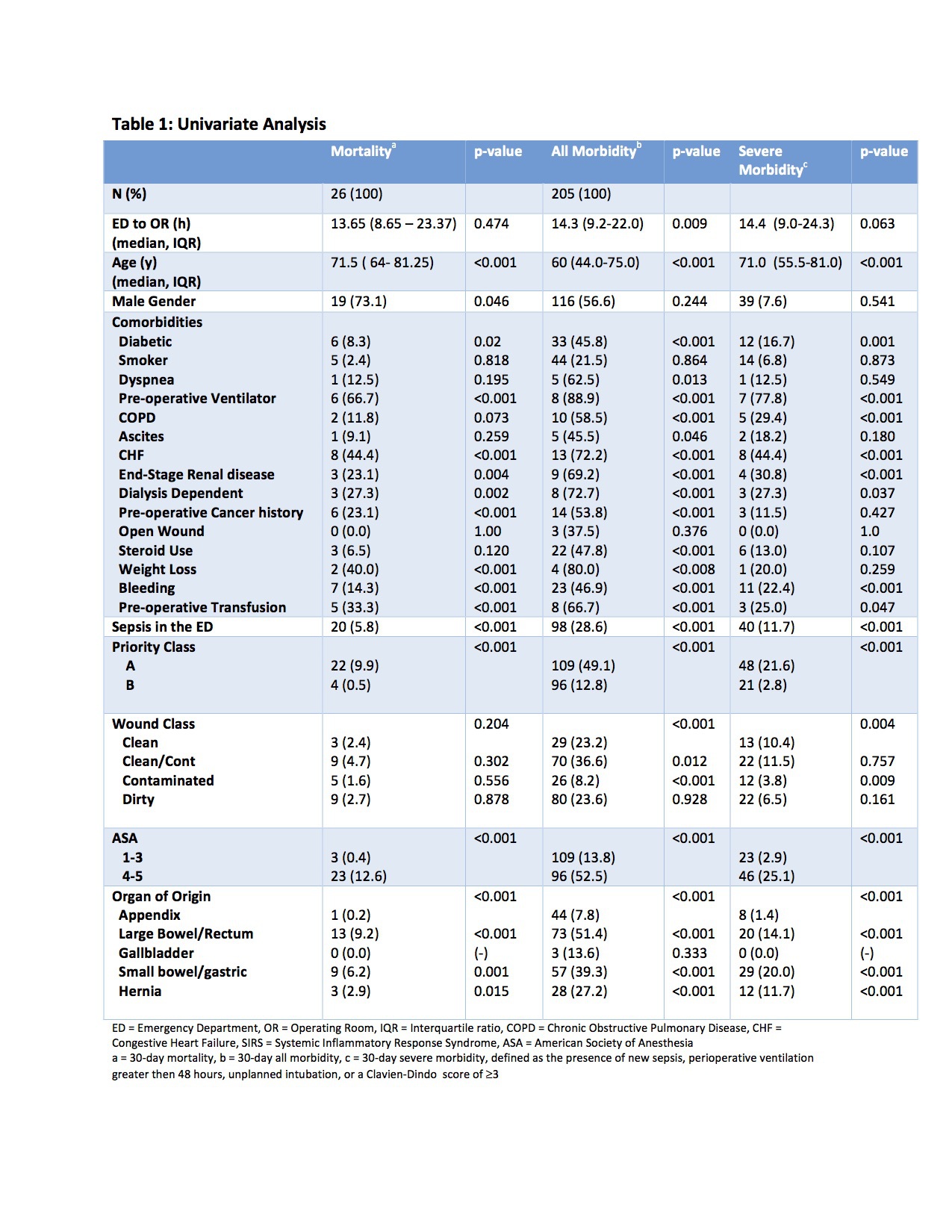|
Back to 2017 Posters
EFFECT OF TIME TO OPERATION ON OUTCOMES IN ADULTS WHO UNDERWENT AN EMERGENCY GENERAL SURGERY PROCEDURE: A LOCAL ACS-NSQIP RETROSPECTIVE ANALYSIS
Trevor Wood*, Arash Azin, Fayez A. Quereshy
Surgery, University of Toronto, Toronto, ON, Canada
Objective: To assess whether an increase in time from emergency department (ED) to operating room (OR) results in changes in mortality and morbidity in acute care surgery.
Background: Patients who have undergone an emergency procedure have an increase in major post-operative morbidity of 1.26-fold and an increase in mortality of 1.39-fold.. Specific variables such as advanced age, ASA classification, and type of procedure have been shown to correlate with an increase in mortality. Amongst this population, time to surgery from arrival to the ED has not been evaluated as an independent risk factor for morbidity and mortality.
Methods: Patients who underwent an emergency general surgery procedure from 2013-2015 at 2 local hospitals were identified using a local American College of Surgeons National Surgical Quality Improvement Project (ACS-NSQIP) database. Outcomes of interest included 30-day mortality, all morbidity, and severe morbidity. The same priority system of case booking (A or B) was used at each hospital. Multivariate analyses were conducted using a logistic regression model utilizing clinically relevant covariates to determine predictors of the outcome measures.
Results: A total of 974 patients were included in the final analysis, of which 57.7% were diagnosed with appendicitis, 14.6% with large bowel and/or rectum pathology, 14.9% with small bowel and/or gastric pathology, 10.6% with an incarcerated hernia, and 2.3% with cholecystitis. Based on the univariate analysis, the median time from ED presentation to OR for mortality, morbidity, and severe morbidity, compared to those who did not experience the defined outcome, was 13.65 hours (p=0.474), 14.3 hours (p=0.009), and 14.4 hours (p=0.063) respectively. The multi-variate analysis showed that patients defined as a priority level A within the fourth quartile with respect to time from ED presentation to OR (>16.9h) had a 2.30 fold increased odds of morbidity (95%CI 1.01-5.24, p=0.048) compared to those in the first quartile (<8h).
Conclusions/Discussion: This study corroborates with known data that morbidity and mortality increases in patients who are older, have multiple comorbidities, and higher ASA class. With respect to the primary objective, without isolating for specific variables, the time from ED arrival to the OR was associated with an overall increase in morbidity. When controlling for covariates, time from ED to OR was found to be associated with increase in overall morbidity for patients who are classified within priority class A. This study sheds light onto the association between morbidity and prolonged time to the OR, an association in which there is a paucity of data despite the common belief that time to OR is of paramount importance. We believe that this finding provides an opportunity for improvement in our current model of patient management.

Table 1: Univariate Analysis

Table 2: Multivariate Analysis
Priority Level A Cases
Back to 2017 Posters
|



